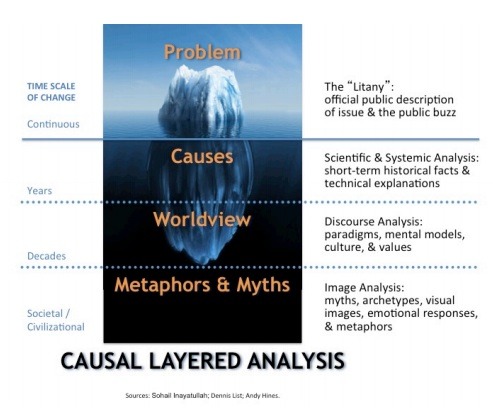Uncovering Causality
Uncovering causality is the first step in the causal layered analysis (CLA) method, which intends to uncover the causes of known issues, facts and assumptions about the present. It looks at the (social) causes, underlying worldviews, myths and metaphors that underpin our current version of reality. CLA was developed by Sohail Inayatullah.
This technique is often used in conjunction that of discovering alternatives, which focuses on creating alternative scenarios for each layer or myth.
Process
A minimal spatial setup for this technique requires a semicircle of chairs facing a large vertical writing surface (black/whiteboard, large piece of paper…). Depending on the size of the group, you might need to have break-out discussions as well.
- Step 1: Frame the exercise, explain the gradual movement down through the 'causal layers', and the goal of the exercise. Let the participants know that you will ask questions to guide the discussions.
- Step 2: Begin the discussion by explaining the first layer: litany, the visible layer of reality, dominated and shaped by the (mass) media. Ask something along the lines of the following questions: 'What is the issue? How is this issue being reported in the media? What might a newspaper headline about this issue look like? What are the known facts and reported data about the issue? What are the current events related to the issue? What is widely believed and not questioned?'
- Step 3: When the issue(s) is/are clearly formulated, move to the next layer: (social) causes, where the issue is analysed based on economic, social, cultural, political and environmental factors. Invite the participants to examine how and why the issue arose. What factors are influencing the issue? Who is involved? What are the underlying causes? Note down summaries of the answers and cluster them thematically.
- Step 4: The next layer to examine is the discourse/worldview layer, which includes the (hidden) social, cultural and even linguistic structures that remained unquestioned by the analysis in the previous layer. This layer looks at cultural values behind the 'powers' that perpetuate the litany. What are the (hidden) assumptions behind the issue(s)? Who are the stakeholders? What are the values they appear to have? Who has the most control over the issue, and what are their dominant worldviews or ideologies? Cluster the discussions into a few dominant worldviews.
- Step 5: The deepest layer is one of myth and metaphor, including collective archetypes and emotional dimensions underlying the worldviews. Discussion about this layer can take different formats, from a simple conversation to working more visually (e.g. using moodboards). However you decide to facilitate this step, the questions are similar: What images arise in your mind when you look at the information uncovered in previous steps? Is there an existing work of of art (in any form) that encapsulates the feelings in which this worldview and the issue is grounded? Are there any myths or folk stories that come to mind?
- Step 6: Invite the participants to reflect on the layered reality they uncovered; ask if there is anything missing, and what their emotional and rational reactions are.

